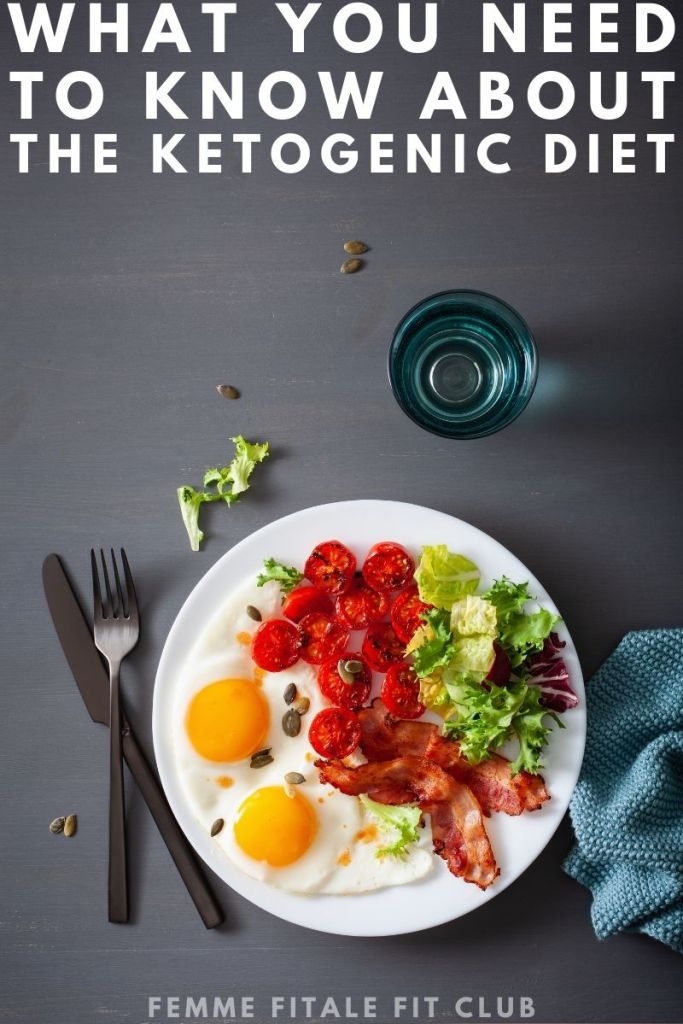If you have considered the ketogenic diet be sure to read this before starting.

What is a ketogenic diet?
Keto, ketogenic, ketosis…these are all words that you may have heard recently. What exactly is a keto diet?
Simply put, a ketogenic diet is a way of eating that includes a low amount of carbohydrates, a moderate amount of proteins, and very high amount of healthy fats.
More specifically, your macro-nutrients levels (or “macros”), the nutritional components of your diet that are required in relatively large amounts (carbohydrates, proteins, and fats), should be comprised of 5% from carbs, 25% from protein, and 70% from healthy fats.
For most people the daily goal for carbohydrate intake is less than 20 grams per day.
Most of those carbs should come from vegetables because these do not come from sugars.
[Tweet “Want to go keto? Read this first. #ketosis #keto #ketogenic #fitfam”]
Your body has three sources of fuel: carbohydrates, proteins, and fat. When eating a ketogenic diet, you switch your body’s fuel source.
The body’s first choice is carbohydrates. Carbs are found in breads, legumes (beans), fruit, grains, and sugars.
Carbs give instant fuel that doesn’t last long. Have you ever had a heavy carb lunch—such as pasta—and crashed after lunch?
Sugar does the same thing—it gives you an instant burst of energy, but causes you to crash shortly after.
If there are no carbs available to burn, the body turns to protein. The body needs some protein to build and maintain muscle. But the body converts excess protein into sugars—which are carbs.
If a diet does not contain an excess of carbs or protein to burn, the body looks for an alternative fuel source—fat. When you deprive your body of excess carbs and protein, you become fat-adapted—a state known as ketosis. Ketosis is the state in which our body begins to use fat as fuel. This is the goal of the keto diet.
When the body is not being constantly overwhelmed with carbs the liver releases ketones which pulls the stored fuel from fat cells to use instead of ingested carbohydrates and protein.

Carbs should be under 20 grams per day and no more than 7-10 carbs per meal. There are disagreements among keto eaters regarding net carbs or total carbs. To find the net carbs, you subtract the grams of fiber because your body cannot digest fiber. Fiber does not raise your blood sugar or insulin.
Most people agree that avocados are a safe keto food.
One avocado has about 17 grams of carbohydrates and about 15 grams of fiber, which means it has a total of 2 net carbs. Avocados are also an excellent source of healthy fats.
The keto diet includes a wide variety of foods:
- Meats—beef, lamb, poultry, eggs, bacon, and fish.
- Leafy green vegetable such as kale and spinach
- Vegetables that grow above the ground such as broccoli and cauliflower
- Nuts and seeds such as macadamias, walnuts and sunflower seeds. (Watch labels because some nuts are higher in carbs than others, and portion size can be very small).
- Sweeteners that do not raise blood glucose levels, such as stevia, erythritol, and monk fruit
- Healthy fats such as olive oil, avocado oil, and coconut oil.
- If you eat dairy be sure to use full fat varieties because low and no fat varieties are usually higher in carbohydrates (Some people cannot tolerate dairy).

Of course, there are things to avoid. A keto diet does not include any refined carbs including grains (i.e. corn and wheat); starch (i.e. potatoes and beans); and sugar (i.e. honey, guava, and maple syrup).
There are many websites, blogs, and social media groups that claim to be “keto friendly”. Remember, different people define keto differently.
It can quickly get very confusing due to all the conflicting information available.
To get started, I recommend you keep it simple: meats, low carb veggies, and healthy fats. After you’ve had a chance to get accustomed to keto, you can try out the many delicious keto recipes found on Pinterest and Facebook.
Just be sure to check the nutrition information or use a recipe analyzer. Myfitnesspal.com has a good one that is easy to use.
Some people will label a low carb recipe as keto, but always check the number of net carbs. Many recipes that claim to be keto friendly often contain too many carbs.
Once you have a good idea of what foods are keto friendly and which ones are not, you will find it easier to follow. One great benefit of following a ketogenic diet is that there is no need for constant calorie counting or measuring.
Have you tried keto? What were your results?

About the guest blogger:
Julie Donahue blogs at Half a Julie (http://halfajulie.blogspot.com) about her journey to lose half her bod weight. She has lost 120 pounds so far—the last 65 pounds following a ketogenic diet. She is currently training for the Yosemite Half Marathon in May 2018.

1 Reply to "What You Need to Know About the Ketogenic Diet"
Xuhi July 13, 2019 (9:58 am)
I am honestly surprised to see this post. It is just an amazing one. This gives complete guide and provides information. Thank you for such a great post.